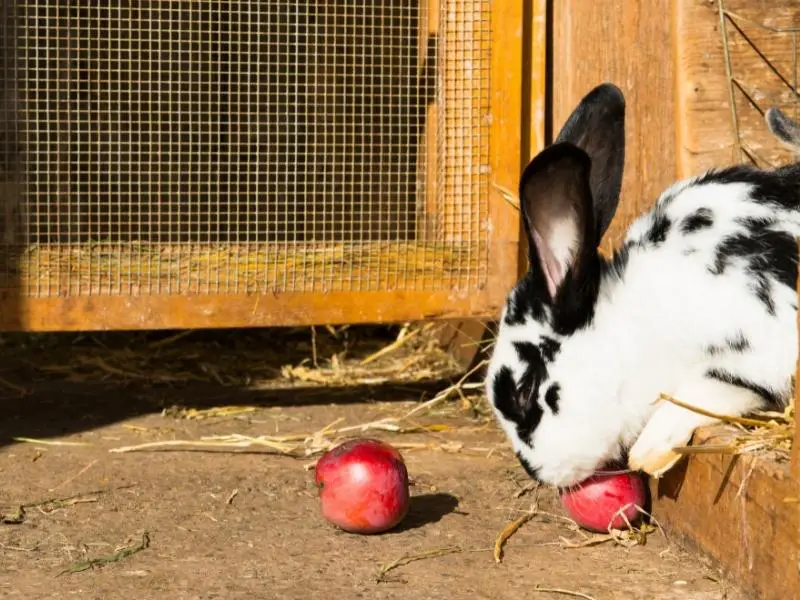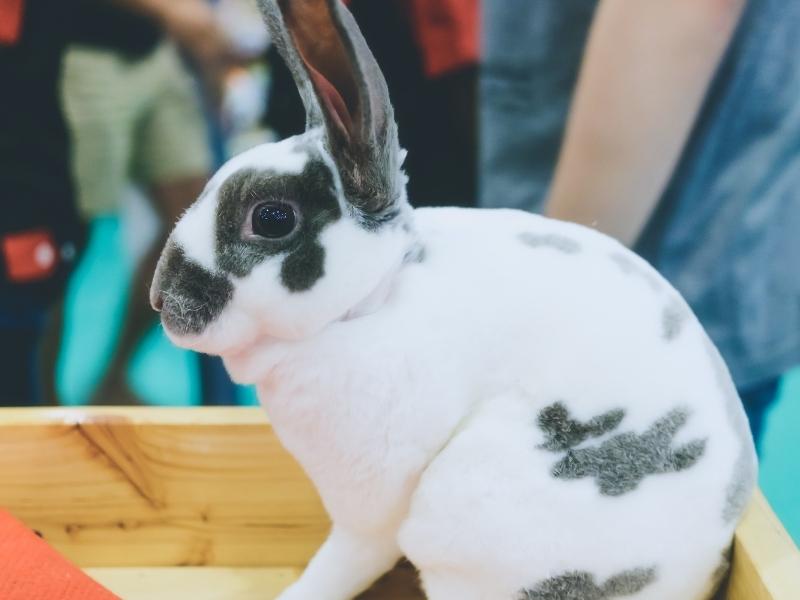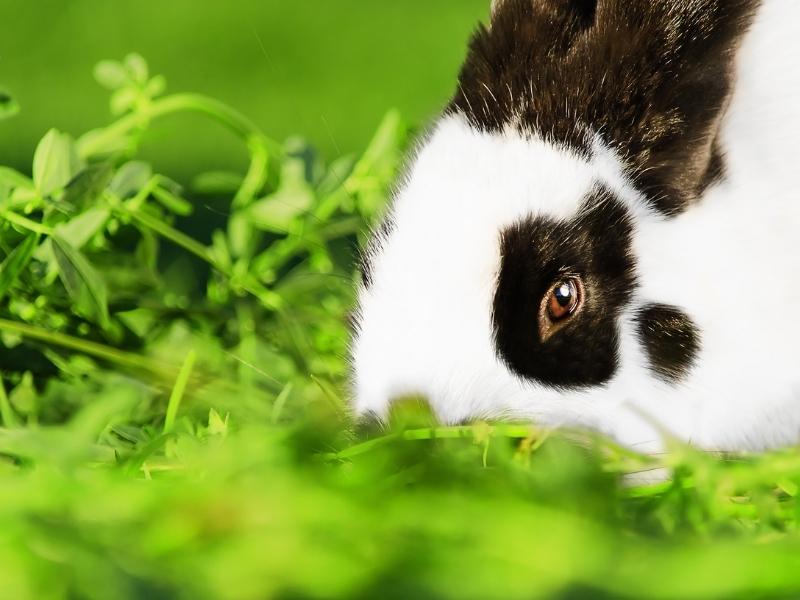If you want a spotted rabbit breed with butterfly markings on its nose, then the Rhinelander rabbit is ideal for you. But what does a Rhinelander look like? And is it an ideal bunny for first-time rabbit owners?
A Rhinelander rabbit has distinct color spots on its cheeks, hindquarters, flanks, and nose. With a white base coat, these spots can be black and orange or blue and fawn. While Rhinelanders are outgoing, they are patient and easy to care for. This makes them ideal pets and if you want a show rabbit.
Where did the Rhinelander breed come from? What rabbits were mated to create this breed?
Let’s find out.
What Is a Rhinelander Rabbit?
A Rhinelander rabbit is a medium-sized domesticated rabbit breed that is recognized by the black/orange or blue/fawn markings on its body.
The most distinct of these is the butterfly-shaped marking on its face, or most notably, its nose area.
With an average lifespan of 5-8 years, this rabbit grows to weigh anywhere in the 6-10 pound region.
It needs a moderate level of care. However, the patient and docile temperament of the Rhinelander makes it a great pet for a first-time rabbit owner.
Rhinelander Rabbit History and Origin
The Rhinelander rabbit was bred by Josef Heintz in Grevenbroich in the North Rhine-Westphalia region in Germany.
The first Rhinelander was produced by mating a Harlequin buck (or Japanese male rabbit) with a gray Checkered rabbit and shown in 1902.
The resulting litter had a bunny with the desired black and orange markings on its ears and chin. The rabbit also had the butterfly markings Heintz wanted.
However, the rabbit had orange markings all on one side of its body and black markings on the other.
So Heintz mated a Harlequin rabbit with a Checkered Giant doe, and one of the female kits had the desired markings and the right colors.
Breeding the kits in the litter with harlequin bucks resulted in the “right” Rhinelander breed, which was standardized in Germany in 1905. The breed was recognized as “Rheinische Schnecke” in Germany.
Between 1908 and 1924, 17 Rhinelanders were shown at the West German Rabbit Exhibition.
In 1923, Rhinelander rabbits were exported to the United States. A year later, the Standards of National Breeders and Fanciers Association of America accepted the breed.
In 1924, Rhinelanders were exported to England and the Netherlands.
Checkered giant rabbits became a very popular choice for rabbit pets in the U.S., so the Rhinelander ceased to exist here. Plus, the standard to breed a Rhinelander rabbit was high, so breeders soon lost interest.
In 1972, the Rhinelander Rabbit Club of America was established because Robert Herchbach bought four Rhinelanders from a German show for his rabbitry. Herchbach also introduced the Mini Lop to Americans.
In 1975, Rhinelanders was once again recognized as a breed by the American Rabbit Breeders Association. Around this time, this rabbit breed became a popular spotted breed in Germany.
The Rhinelander bunny is currently on the “watch” status on a list by The Livestock Conservancy. The global population of Rhineladers is around 2,000 rabbits, with fewer than 200 U.S. registrations every year.
The British Rhinelander Club has designated this rabbit breed as rare.
Rhinelander Rabbit Characteristics

The following characteristics set the Rhinelander rabbit apart from other rabbit breeds:
Appearance
The Rhinelander is a large rabbit breed that has a full arch body. This means that you can see light between the rabbit’s body when it sits or moves and the ground.
An adult Rhinelander weighs between 6.5-10 pounds.
These bunnies have long limbs, and the width of their hips and shoulders is the same. Rhinelanders have long V-shaped ears that measure 4.75 inches. Their ears always stand upright, making them look alert.
A Rhinelander rabbit has chestnut brown eyes and a short, dense coat. You don’t need to groom this often to keep it looking good, making them relatively easy to care for.
Temperament
Rhinelander rabbits are patient and docile; however, they are also outgoing and active. Thus, they are ideal for people who are single or have families and seniors. If you have kids, teach them how to care for rabbits and how to pick up rabbits.
As talkative rabbits, Rhinelanders squeal in excitement, especially if they see their fur parents. Like a cat, these bunnies also purr when they are happy and content.
These bunnies are also curious, so they enjoy spending time playing with rabbit-friendly toys.
Color Varieties
Two Rhinelander rabbit color varieties are accepted by the American Rabbit Breeders Association (which recognized the breed in 1925).
The base coat of a Rhinelander is white. These bunnies have markings in two different colors: black and orange/yellow or blue and fawn. The second color combination was accepted in 2012.
Interestingly, the mottled pattern of orange and black markings is called Japanese Brindling.
Like an English Spot rabbit, a Rhinelander should have eye circles and colored ears. The marking on their nose should resemble a butterfly, and there should be cheek spots below their eyes.
If you want your Rhinelander rabbit to be show-worthy, check that your rabbit has between 2 and 10 flank and hindquarter spots. The spots should be in both colors according to the color breed of your Rhinelander.
Rhinelanders also have a dorsal stripe along their spine in either black/orange or blue/fawn.
Rhinelander Rabbit Care

If you own one of these rare rabbits, here’s how to take proper care of your Rhinelander:
Enclosure and Temperature
A Rhinelander rabbit needs a minimum enclosure size of 2×4 square feet. Their run should be bigger (a minimum of 2×6 square feet) so this bunny has enough space to exercise and play.
In total, their enclosure should be 4×10 square feet. Double this if you have two rabbits.
You can keep your Rhinelander either indoors or outdoors. For an outdoor hutch, ensure it is weather and predator-proof. Surely you don’t want your precious fluff ball eaten by a fox, snake, or another rabbit predator?
Rabbits do seem to be healthier if they are kept indoors because extreme weather conditions have negative effects on their health – unless you make sure your bunny is safe and well protected from the elements outside.
The outdoor hutch needs to be raised from the ground and made from either metal wire mesh or wood.
Diet
Similar to any other rabbit, your Rhinelander’s diet should comprise 70% high-quality hay. This ensures your bunny stays healthy.
About 20-25% of their diet should be fresh leafy greens, and the rest should be treats in the form of alfalfa and grass pellets, veggies, and fruit.
Remember, don’t feed your bunny lots of food that is high in calories or sugar. Rabbits don’t need sugar for energy. If your rabbit eats a high-sugar diet, it will become unhealthy and obese.
Grooming
Groom your Rhinelander rabbit every other week when it isn’t molting season. This removes stray hairs and ensures your rabbit’s coat remains healthy and shiny.
During molting or shedding season, regularly brush your bunny to help them molt and to make cleaning up easier for you.
Cleaning
Don’t bathe your Rhinelander; submerging your bunny in water causes it to stress and it could die of a heart attack.
With a hypoallergenic, alcohol-free baby wipe, spot cleans your rabbit. If there are wet spots on its fur, use cornstarch powder to dry the spots. With a rabbit-friendly comb, brush through your Rhinelanders coat – this helps dislodge dirt, thus cleaning the fur.
Health
Rhinelanders are mostly healthy rabbits and not predisposed to serious health issues.
Ensure your rabbit gets all the vaccinations they need and take the bunny for regular checkups at the vet.
A big part of ensuring your bunny stays healthy is feeding them a healthy, balanced diet and ensuring they are physically and mentally stimulated.
Lifespan
On average, Rhinelanders live for 5-8 years. However, with proper care, these bunnies can live for 10-12 years, making them lifelong companions for any rabbit lover.
Breeding Rhinelander Rabbit
Rhinelanders are bred for these purposes:
As Pets
With their easy-going temperament and because they are easy to care for, Rhinelanders make great pets.
They are ideal whether you are a first-time bunny owner or an experienced showing enthusiast. Since they are medium-sized, they fit in well with apartment living, provided their enclosure is large enough.
Bond two Rhinelanders to ensure your bunny is always happy and has 24/7 companionship. Rabbits are social animals, after all.
For Shows
With their distinct color markings, Rhinelanders are mainly bred for show purposes.
As a moving breed, they move around the show table at exhibitions. Most other rabbit breeds are statically posed.
Rhinelander Rabbit Price
You can buy a Rhinelander rabbit for between $40-60. However, expect to pay more if your bunny comes from a bloodline of Rhinelanders that did well at shows.
Conclusion
Rhinelander rabbits are rare, with their numbers dwindling every year. It is quite something if you have a Rhinelander as a pet rabbit or are thinking of getting one.
These bunnies are easy to care for. They are patient and kind but need lots of exercise and stimulation to keep them healthy.


